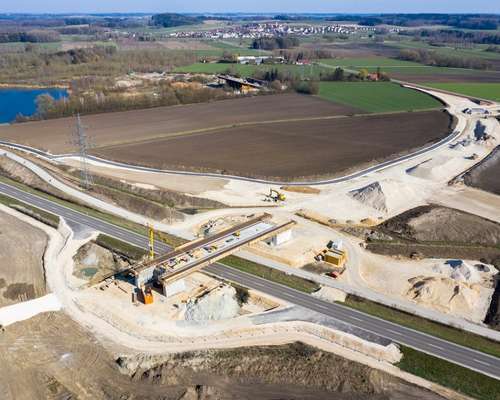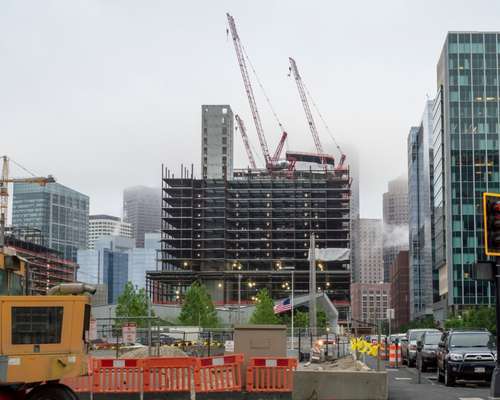1 Minute Read
August 31, 2022
0%
Summer is over. Fall has arrived. In the world of construction, it seems things are on the rise! Nickel poetry aside, there appears to be a lot of good news lately for the construction industry. Some of the headlines we were following in September include price drops for construction materials, significant movement on BIM practices in the United States, and many more high-dollar projects ahead! Read on for more.

In some good news, it seems that the surging prices for construction materials has, at least for the moment, come to an end. Prices for everything from lumber to crude petroleum to iron and steel have fallen over the past couple of months.
Construction Dive reported in September that construction input prices fell for the second straight month, down 1.4% overall. While that may not seem like a huge dip after months of cost bumps and materials supply chain issues, some of the most critical components are seeing the biggest drops. The cost of iron and steel was down 5.1%, while steel mill products were down 5.7% and crude petroleum dropped 5.3%.
In July, ForConstructionPros.com noted that softwood lumber prices—one of the most volatile construction products in terms of costs—had dropped 35% since March 2022. In mid-September, Market Watch noted another 6% drop to $532.30 per thousand board feet, and lumber prices have fallen nearly 50% overall in 2022.
Costs of many other construction materials have slowed or plateaued as well. Though some materials, like concrete (up 1.5%) and natural gas (up a staggering 35.3%) are still hitting contractors’ pocketbooks hard.
The Takeaway: Now this is a trend line we like to see! Yes, the costs of nearly all construction materials are still above their pre-pandemic levels (lumber’s price drop finally has it back near the rate it was at before Covid), but this is a good sign for work ahead. Despite inflation, and production and supply chain challenges, prices may be leveling off.
Of course, the lessons learned during the pandemic that forced contractors to be more agile and keep better watch over their materials and related processes shouldn’t fall by the wayside. Cutting down on misuse and waste of materials through more streamlined construction management, and preventing theft though better scheduling and innovative project site safeguards, are all actionable items that should continue.

Though project starts on the whole have stagnated a bit in 2022, there are further signs that the construction industry remains bullish on the future. We’ve already seen scores of $1 billion-plus megaprojects that have been announced or broken ground this year, and several more made headlines in September. Here’s a quick look at just a few of these.
The Takeaway: The sheer amount of major construction projects coming online is a good sign that the industry is poised for continued success in the years ahead. We’ve moved from contractors stockpiling cash reserves to spending on materials, project planning, hiring and more. There is plenty of work to be done, and prospects are bright for construction firms to earn big bucks.
But with these, and even many smaller projects, come a lot more contractual and compliance demands than contractors have traditionally dealt with. These include having the latest construction technologies in place, real-time financial and compliance reporting, more robust diversity, equity and inclusion practices among workforces, and increased measures toward more sustainable building practices.
And, contractors still face challenges when it comes to areas like finding, training, and retaining skilled labor, and eliminating project inefficiencies from legacy workflows and processes. That’s why so many construction firms are moving to modernize their operations with cloud-based, connected construction management solutions.

Massachusetts has rolled out a new pilot program that bans fossil fuels from most new construction projects, with the exception of labs and hospitals. The Boston City Council in September voted 9-3 to sign up to participate in that program.
The program is aimed at fostering more clean energy and sustainable construction initiatives in an effort to mitigate climate change. However, opponents of the program worry it could drive up development costs, as well steer developers away from Boston and exacerbate its current housing crisis.
“I don’t disagree about de-carbonizing our buildings, but ... it needs to be done gradual,” Councilor Frank Baker of Dorchester told Boston’s local NPR station, adding that the measure needed much more input from union workers whose livelihoods could be impacted by such a sudden shift towards clean energy.
The Takeaway: This is an area to pay close attention to. This program, and other similarly ambitious sustainability movements we’re seeing across the country, are certainly well intentioned. The move toward zero-emission, carbon neutral construction is important. In fact, the construction industry in recent years has been driving significant green building and sustainable construction practices.
Yet, measures like the one above feel like it might be forcing a square peg into a round hole too fast, too soon. A city or metro area like that of Boston can have hundreds of contractors with deep roots and special knowledge of the communities they serve. Few of these contractors, though, could move to a completely fossil-fuel free construction environment quickly without taking some huge hits in equipment and management costs, training and more—essentially tearing up and redefining their business model altogether.
Perhaps a middle of the road compromise can be found, with incentives like tax breaks or project bonuses for contractors that deploy higher percentages of sustainable construction practices or use less fossil fuels per project. Or, maybe a more structured plan could be enacted allowing contractors to their fossil fuel use over time, allowing them to switch to more eco-friendly workflows without blocking them from the work opportunities they depend on for their livelihoods.

The National Institute of Building Sciences (NIBS) announced the launch of a nationwide BIM program with the aim of creating a BIM standard for the United States.
The U.S. National Building Information Management (BIM) Program would focus on boosting construction productivity through the use of digitization and innovative construction technologies. The organization said that the lifecycle of U.S. construction projects should be much more efficient, less expensive, more resilient, and safer to build and maintain.
“Many national and international initiatives focus on BIM standardization to support digital transformation throughout the entire life cycle of designing, constructing, and operating the built environment,” said Stephen T. Ayers, FAIA, Interim CEO of NIBS in a September press release. “The U.S. National BIM Program will be successful through collaboration between the public and private sectors and across the diversity of project stakeholders, namely owners, designers, constructors, suppliers, vendors, and other involved parties.”
The Takeaway: This is good news, and frankly, it’s great to see this moving past the “just being discussed” phase here in the States. Like Ayers notes, BIM practices have been a resounding success in other international construction jurisdictions—especially the United Kingdom, where it has been made a governmental building standard. Digitization, visual modeling and other leading-edge construction technologies are taking a lot of the work-and guesswork-out of the construction process, reducing errors, delivering stronger, more profitable projects faster, and leading to more sustainable construction processes.
Want more takes on news and issues permeating the construction industry? Be sure to subscribe to our blog for the latest trends and industry news, or visit viewpoint.com to learn how leading-edge technologies can help grow your construction operations.
1 Minute Read
August 31, 2022
1 Minute Read
August 3, 2022
1 Minute Read
June 30, 2022